Powering sustainable transformation
Your Azure investments make you part of the global community committed to reducing energy use, a more carbon-neutral grid, and a greener future.
Microsoft addresses how our cloud infrastructure impacts the environment and communities by investing in advanced development projects for carbon, waste, water, and ecosystems.
Microsoft’s sustainability commitments
LEED Gold certification for newly built datacenters
$1 billion Climate Innovation Fund
Commitment to protecting more land than we use by 2025
Zero-waste certification by 2030
Water positive by 2030—replenish more water than we consume
Diesel-free backup power by 2030
100 percent of our electricity consumption, 100 percent of the time, matched by zero carbon energy purchases by 2030
Watch to learn more about the importance of including datacenters in the solution for broad decarbonization.
Importance of addressing global sustainability
Every internet search, video call, and text message impacts global consumption of power, water, and land. The more data we consume, the more resources we consume.
Humanity can’t progress without data. Emerging technologies bring the promise of giant leaps forward in how we live—but this can’t come at the cost of our planet. We realize the importance of keeping our planet healthy and minimizing our impact on the globe, and Microsoft is fully committed to addressing sustainability with our datacenters.
The remainder of this tour will show how Microsoft will address global sustainability now, and for years to come. It is our mission to leave the world a better place, and these are just the first of many steps we are taking to do so.

We are committed to growing our business responsibly by operating environmentally sustainable datacenters.
Azure services are up to 98 percent more carbon efficient and up to 93 percent more energy efficient than a traditional enterprise datacenter.

Meaning, measurement, and markets
We need to make significant progress in three core areas of the global climate conversation: the meaning of net zero, the measurement of net zero, and the markets that will support net zero.
In the following exploration, we’ll dive into some of the markets where we’ve developed tools to monitor and manage water usage, calculate the decarbonization impact of renewable energy, and reduce carbon emissions.
Watch to learn more about the Microsoft Cloud for Sustainability.
Microsoft Cloud for Sustainability
Microsoft Cloud for Sustainability allows organizations to effectively record, report, and reduce their carbon emissions—setting them on the path to net zero.
Microsoft Cloud for Sustainability, a software as a service (SaaS) solution, integrates with many powerful products, applying a common format to connect data from various sources while helping organizations capture and understand data across siloed systems. It helps companies like yours reduce your carbon footprint, improve processes, and make lasting organizational changes.
Watch to learn more about the world’s first hourly matching of renewable energy.
Sweden
Matching hourly renewable energy with Vattenfall
Microsoft is among the largest purchasers of renewable energy in the world, with operating and contracted renewable energy projects totaling 7.8 gigawatts globally. We have more than 35 power purchase agreements thus far, setting us on our pursuit to achieve 100 percent renewable energy consumption by 2025.
By 2030, Microsoft will accomplish what we refer to as 100/100/0 by matching 100 percent of our electricity consumption 100 percent of the time and making zero carbon energy purchases.
Watch our Explanimators video to learn more about decarbonization
We’ve also built one of our most sustainable cloud regions in Sweden that launched in November 2021. This will enable us to use 100 percent renewable energy for each hour of consumption. Sweden will be the first Microsoft region to use lower-carbon renewable fuel for backup power.
Investing in solar power
Ten years ago, solar and wind power represented 1 percent of global electricity generation—but by 2050, this will shift to 50 percent.
By 2025, Azure looks to shift to 100 percent renewable energy supply.
We launched our sustainable datacenter region in Arizona, where we’re working with Longroad Energy on its 150-megawatt photovoltaic solar power plant. This renewable energy will offset the energy use of the new campus, resulting in renewable energy certificates for the project.
For more than half a year, the new region won’t use any water for cooling. Instead, it will use a method called adiabatic cooling, which uses outside air instead of water for cooling.

Project Zerix
Microsoft is investing in a sustainable future through zero environmental impact materials.
Project Zerix aims to achieve net-zero embodied carbon and net-zero waste in our datacenters and beyond through the use of biodegradable plastics, sustainably printed circuit boards, and bio-concrete materials.
What we’ve done:
Our datacenters in San Antonio, Texas and Columbia, Washington have achieved zero-waste certifications
Our datacenters in Boydton, Virginia and Dublin, Ireland have both renewed their zero-waste certifications
By 2030, we will:
Divert at least 90 percent of the solid waste from our campuses and datacenters
Build Microsoft Surface devices to be 100 percent recyclable
Use 100 percent recyclable packaging
Divert 75 percent of construction and demolition waste
Watch to learn how circular centers will help Microsoft achieve zero waste by 2030.
Amsterdam
Achieving zero waste with Microsoft Circular Centers
We expect Microsoft Circular Centers to increase the reuse of our servers and components by up to 90 percent by 2025.
Inspired by the concept of circularity, we will build new centers on select datacenter campuses designed to extend the lifecycle of our servers and minimize the waste sent to landfills.
The expanding number of Microsoft Circular Centers has already reduced carbon emissions by 145,000 metric tons of carbon dioxide equivalents last year.

Liquid immersion cooling methodology
Around the world
Real tech ready to power the future of AI
Within two years, most cloud AI compute will need to process on advanced chips that run too hot to be cooled by conventional air circulation techniques.
Immersing the AI chips on server blades in low-boil dielectric fluid improves latencies and throughput while providing better overall performance—and it’s one of many steps we’re taking toward datacenters with lower energy consumption, higher processing power, and less water consumption.
Run advanced AI workloads on Azure to lower your power usage and eliminate indirect water consumption, benefitting both the environment and water-stressed communities.
Advanced microchips today have six times more processing power than standard chips.

Through modern and innovative techniques, we are reducing the use of cooling water in our datacenters
With open-air cooling, adiabatic cooling, and liquid immersion, we’re reducing the amount of cooling water used in our datacenters. We are committed to being water positive by 2030.
Adiabatic cooling is a highly efficient method of cooling datacenters that uses evaporation rather than mechanical air conditioning. It requires a fraction of the electricity needed for a legacy datacenter and up to 90 percent less water than other water-based cooling systems, and depending on local conditions and accessibility to reclaimed water, can be used with both indirect evaporative cooling (IDEC) and direct evaporative cooling (DEC).
Our datacenters are also taking advantage of rainwater by capturing, treating, and using it for on-premises cooling to help supplement the water supplies we consume in regions like Amsterdam and Dublin.

Benchmarking ecosystem performance
By 2025, Microsoft commits to protect more land than we use for our datacenter expansion.
We measure our ecosystem performance based on:
- Water quantity and quality
- Air, carbon, and climate
- Soil health
- Health and wellbeing
- Biodiversity
For this initiative, Microsoft has identified 12 datacenter regions to provide benchmarks for our ecosystem performance. The findings of this research help to inform an ongoing project in our Amsterdam region, where we will construct a lowland forested and wetland area around the datacenter that’s suited to naturally process storm water and runoff. Results from these approaches indicate ecosystem performance can be improved as much as 75 percent.
Our goal is to renew and revitalize the surrounding area so we can perform at least as well as nature and establish mutual, regenerative value for the local community and environment.
Generating IT jobs
The Microsoft cloud will help add 2.5 million new skilled IT jobs to the global economy by 2025.*
*IDC White Paper: Microsoft Cloud Dividend Assumptions and Methodology, sponsored by Microsoft, doc #US48022121, July 2021

Northlake Centerpoint Preserve Bioswale
Partnering with Northlake Police Memorial Fund, Inc. in Illinois, Microsoft is building a local bioswale to convey stormwater runoff while removing debris and recharging ground water.
A bioswale is a sunken area with native plants—and implementing one around our Northlake datacenter can greatly benefit the surrounding area by helping to reduce water flowing through gray infrastructure and collection systems that are overwhelmed by intense rain events in the region.
When completed, the bioswale will not only enhance the beauty of the environment, but also educate the community about environmental impacts. A linking walkway and signage will show the benefits of the bioswale and the types of plants and animals that will use it as a natural habitat.
Meeting the world’s needs, one workload at a time
Little did you know your corporate actions can help to add new jobs, match energy needs in Sweden, reduce waste in Amsterdam, and more—but that’s exactly what an investment in Azure translates to. And these are just a sample of the outcomes your cloud investments create.
